How to Send a Push or Email Notification When a Trigger Happens
Required Permissions
This section requires the Application Designer permission from your Domain's administrator.
Check What are the Design Tasks? to learn more about permissions to work with Design Mode and other tools.
Summary
Learn how to send either a Email or Push notification when certain conditions in your application occur.
Email Notification¶
Follow the steps below to create a Send Email Custom Action.
-
In Design Mode, click on the icon in the upper-right corner of any panel.

The action leads to the Custom Actions panel.
-
Click on the Enable Module toggle switch to activate the Custom Action panel in Design Mode.
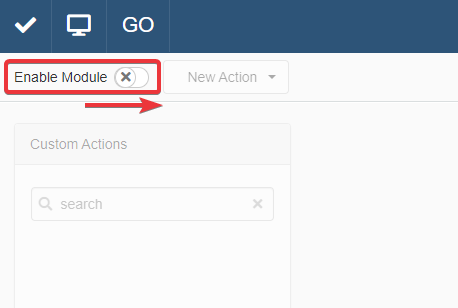
-
Click on the New Action drop-down menu button.
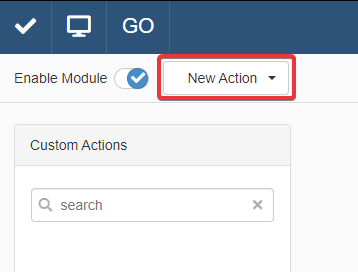
-
Choose the Send Email type from the list of Custom Actions types. This action creates a Send Email Custom Action.

This action creates the Send Email Custom Action to be configured.
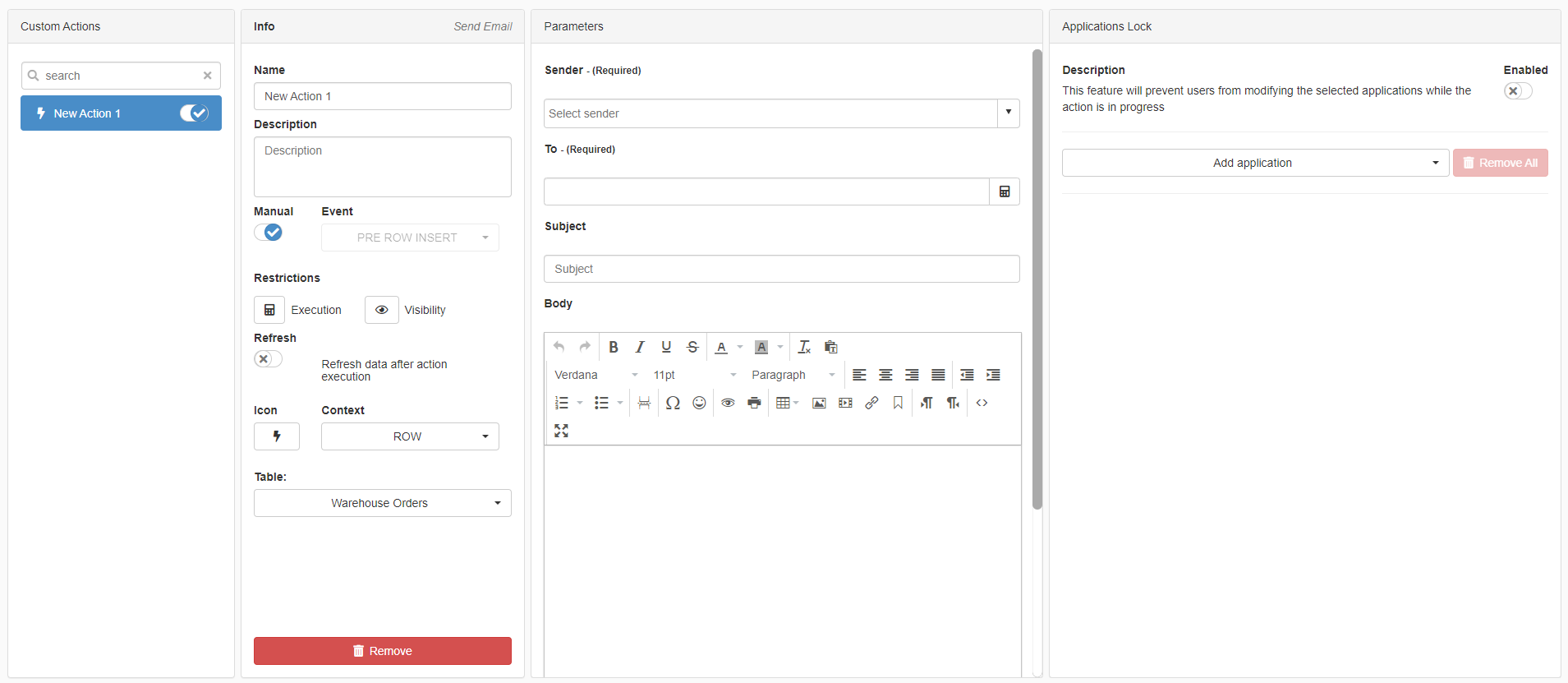
-
Insert in the Info section the required information
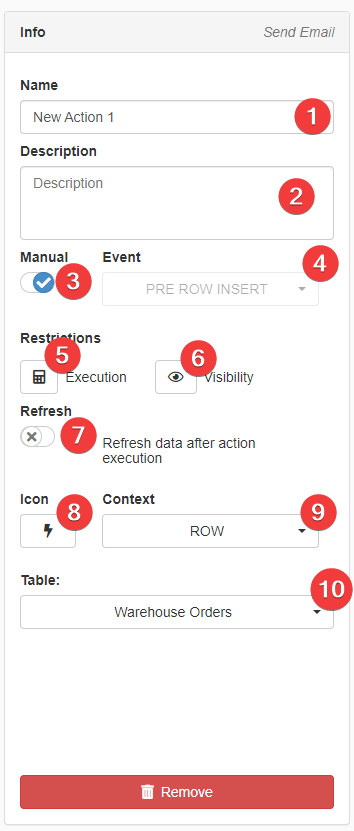
- (1) Name Insert a name for the Send Email Custom Action.
- (2) Description
optionalInsert a description for the Send Email Custom Action. - (3) Manual If enabled, the Users launch this Custom Action manually. If disabled, choose at (4) Event a triggering condition to launch the Custom Action. (By default, the toggle switch is enabled.)
- (4) Event If (3) Manual is disabled, choose a trigger condition from the drop-down list.
Event - Triggering Options
For the Event option, when the Manual toggle-switch is disabled, choose a moment when the Custom Action runs.
PRE ROW INSERT Before inserting a row.
POST ROW INSERT After a row's insertion.
PRE ROW UPDATE Before any changes apply to a row.
POST ROW UPDATE After having edited a row.
PRE ROW DELETE Before deleting a row.
POST ROW DELETE After having deleted the row.
PRE ATTACHMENT INSERT Before uploading an attachment to a row.
POST ATTACHMENT INSERT After having uploaded an attachment to a row.
POST MASTER INSERT After having inserted a row on the Master table.
POST MASTER UPDATE After having saved an edited row on the Master table.
POST MASTER DELETE After having deleted a row on the Master table.
- (5) Execution
optionalClick to open the Formula Editor. Insert a Formula to define the conditions for executing the Custom Action. - (6) Visibility
optionalClick to open the Formula Editor. Insert a Formula to define the conditions to display the Custom Action in the application. - (7) Refresh
optionalIf enabled, the application refreshes the data on the table when the Custom Action has finished to run. - (8) Icon
optionalChoose an icon for the Custom Action. - (10) Context Decide if the User launches the Custom Action from the Custom Actions drop-down menu in the application or from the Row's Options (). Disabled if (3) Manual is disabled.
- (10) Table Choose the table where the Custom Action runs.
-
In the Parameters section, choose the settings for the Send Email.
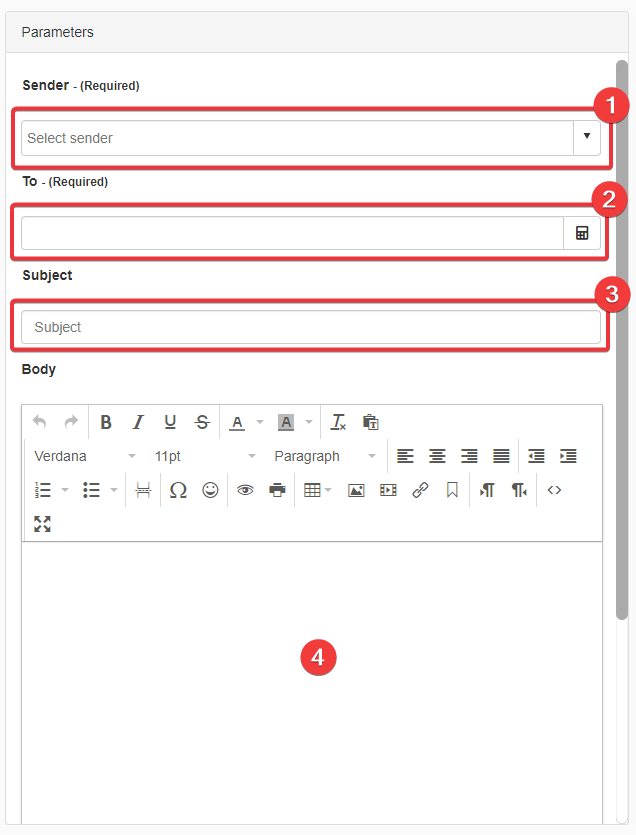
- (1) Sender Choose an email address from the list that your administrator has configured.
- (2) To Type the email addresses that must receive the email notifications. As alternative, click on the to open the Formula Editor. Insert a formula determining the email addresses' list according to one or more conditions.
- (3) Subject Insert a standard subject for the email notification. You can insert Formulas between
[]. - (4) Body Insert the content of the email's notification by using the embedded editor. You can insert Formulas between
[].
Attention
Inserting formulas either in the Subject or the Body requires enclosing the formula between two squared brackets
[]. Inside Subject and Body in Send Email Custom Actions, applications interpret formulas outside squared brackets[]as standard text and won't run them.Hint
See examples about using Formulas in Send Email Custom Actions in the Formulas Use Cases
Hint
You can paste inside the Send Email's Body's editor HTML Code.
Click on the Source code button in the editor's toolbar.
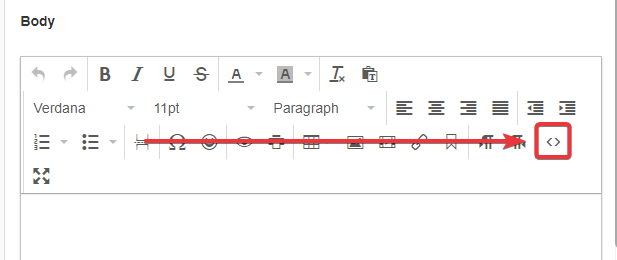
(1) Paste the HTML Code and (2) click on Ok button (or Cancel to abort the action).
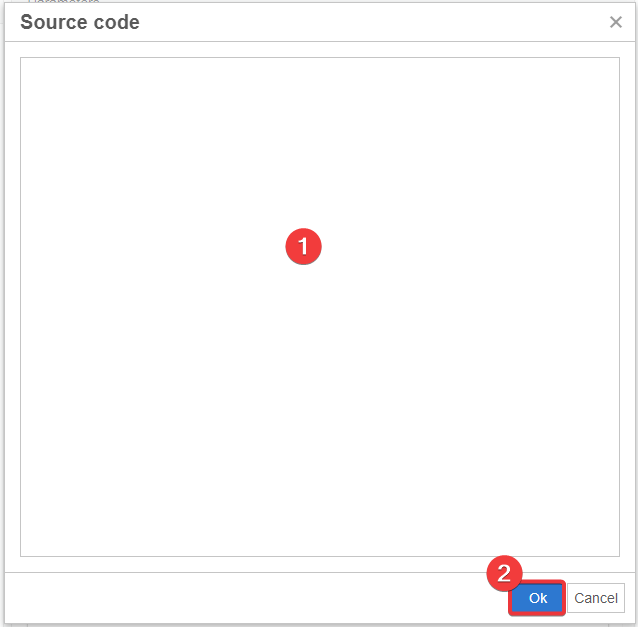
The editor will render the HTML code in the Send Email action's message.

-
This step is optional. Follow this step if you want to block the use of one application while the Custom Action is running.
In the Application Lock, click on the Enabled toggle switch to enable the applications' locking. (By default, Enabled is turned OFF.)
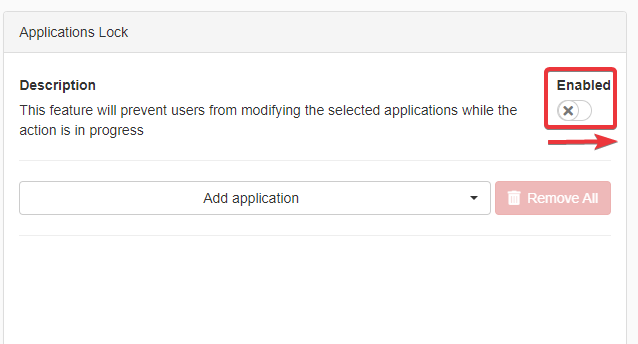
Choose one application from the drop-down list to lock while the Custom Action is running.

-
When you have completed the configuration, click on the Save button () in the top-left corner to save the Send Email Custom Action.

Success
You have configured a Send Email Custom Action. If the conditions occur, the application sends an email notification.
Hint
If you want to disable the Send Email Custom Action without deleting it from the Application, click on the toggle switch next to the Custom Action's name to hide it from the users.
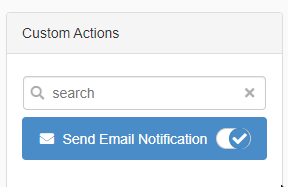
Hint
If you want to delete a Send Email Custom Action, click on the Remove in the Info section.
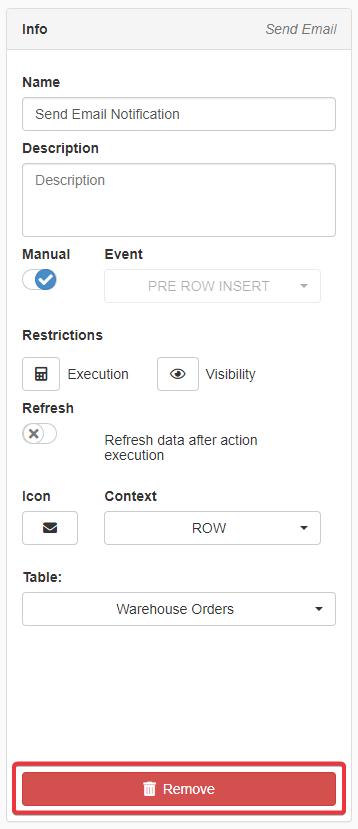
A window will ask for confirmation. Click Yes to confirm the deletion. (Click No to abort the deletion.)

Click on the Save button () in the top-left corner to save the deletion.
Push Notification¶
Follow the steps below to create a Push Notification Custom Action.
-
In Design Mode, click on the icon in the upper-right corner of any panel.

The action leads to the Custom Actions panel.
-
Click on the Enable Module toggle switch to activate the Custom Action panel in Design Mode.

-
Click on the New Action drop-down menu button.

-
Choose the Push Notification type from the list of Custom Actions types. This action creates a Push Notification Custom Action.

This action creates the Send Email Custom Action to be configured.

-
Insert in the Info section the required information

- (1) Name Insert a name for the Send Email Custom Action.
- (2) Description
optionalInsert a description for the Push Notification Custom Action. - (3) Manual If enabled, the Users launch this Custom Action manually. If disabled, choose at (4) Event a triggering condition to launch the Custom Action. (By default, the toggle switch is enabled.)
- (4) Event If (3) Manual is disabled, choose a trigger condition from the drop-down list.
Event - Triggering Options
For the Event option, when the Manual toggle-switch is disabled, choose a moment when the Custom Action runs.
PRE ROW INSERT Before inserting a row.
POST ROW INSERT After a row's insertion.
PRE ROW UPDATE Before any changes apply to a row.
POST ROW UPDATE After having edited a row.
PRE ROW DELETE Before deleting a row.
POST ROW DELETE After having deleted the row.
PRE ATTACHMENT INSERT Before uploading an attachment to a row.
POST ATTACHMENT INSERT After having uploaded an attachment to a row.
POST MASTER INSERT After having inserted a row on the Master table.
POST MASTER UPDATE After having saved an edited row on the Master table.
POST MASTER DELETE After having deleted a row on the Master table.
- (5) Async Enable to run the Custom Action in the background instead of waiting for its completition to use the application. (By default, the Async toggle-switch is enabled when (3) Manual is enabled. Otherwise, the toggle-switch is disabled.)
- (6) Execution
optionalClick to open the Formula Editor. Insert a Formula to define the conditions for executing the Custom Action. - (7) Visibility
optionalClick to open the Formula Editor. Insert a Formula to define the conditions to display the Custom Action in the application. - (8) Refresh
optionalIf enabled, the application refreshes the data on the table when the Custom Action has finished to run. - (9) Icon
optionalChoose an icon for the Custom Action. - (10) Context Decide if the User launches the Custom Action from the Custom Actions drop-down menu in the application or from the Row's Options (). Disabled if (3) Manual is disabled.
- (11) Table Choose the table where the Custom Action runs.
-
In the Parameters section, choose the settings for the Push Notifications.
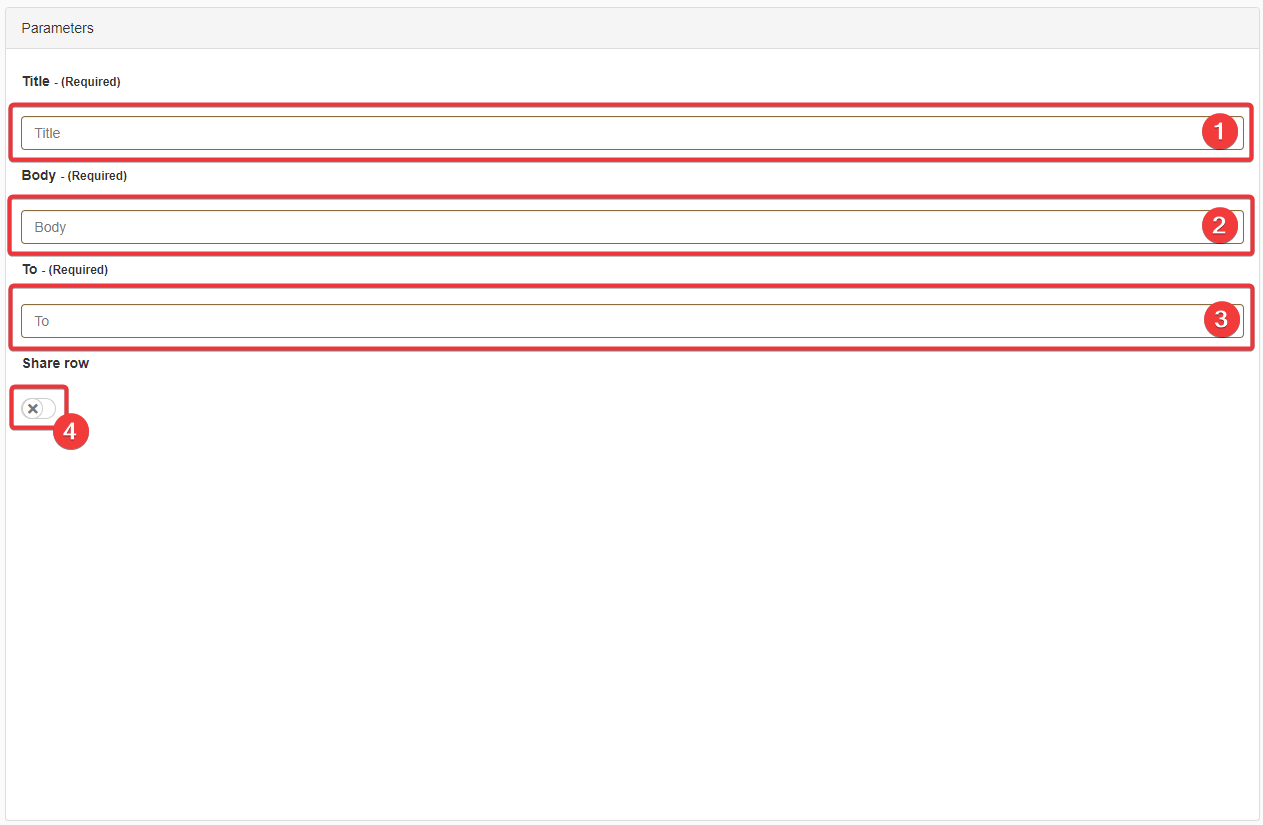
- (1) Title Choose a name for the notification.
- (2) Body Insert the text for the Push Notification.
- (3) To Insert one or more email addresses that will receive the Push Notification.
- (4) Share Row Decide if the push notification should lead to the table's row when clicked. By default, Share Row toggle-switch is turned OFF.
-
When you have completed the configuration, click on the Save button () in the top-left corner to save the Push Notification Custom Action.

Success
You have configured a Push Notification Custom Action. A notification reaches the devices of the specified email addresses.
Hint
If you want to disable the Push Notification Custom Action without deleting it from the Application, click on the toggle switch next to the Custom Action's name to hide it from the users.
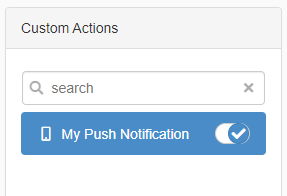
Hint
If you want to delete a Push Notification Custom Action, click on the Remove in the Info section.

A window will ask for confirmation. Click Yes to confirm the deletion. (Click No to abort the deletion.)

Click on the Save button () in the top-left corner to save the deletion.